This is the best sticky date pudding, made from scratch. Ultra-moist date and brown sugar sponge cakes are doused in a rich caramel sauce and served with a dollop of whipped cream or vanilla ice cream. A beloved comfort classic, this dessert is so easy to make and is a guaranteed crowd pleaser!
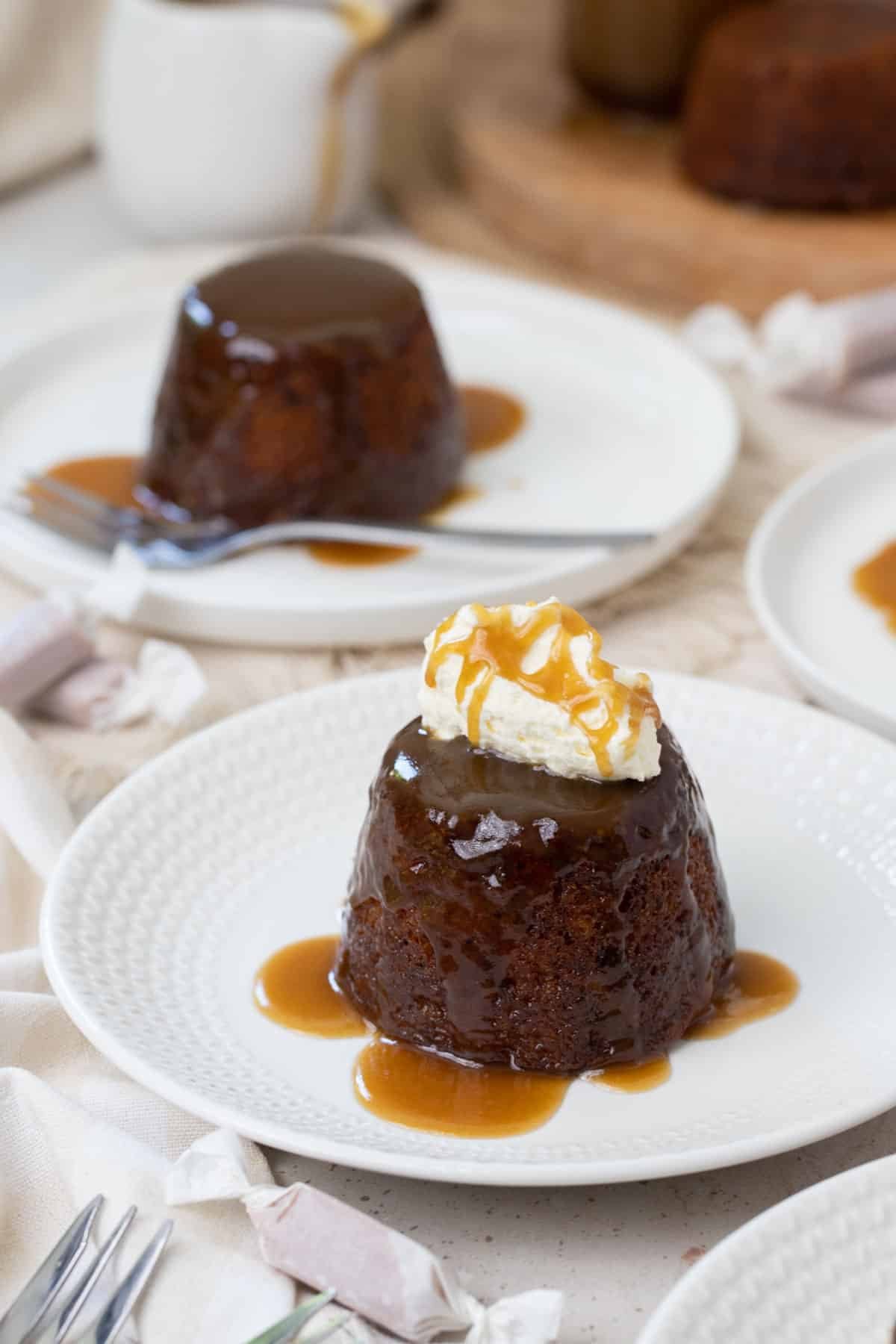
Why you’ll love this recipe
- Easy to make – a reliable, easy recipe with basic ingredients.
- Make ahead – both the puddings and the sauce can be made ahead of time and reheated when you are ready to serve them.
- Freezer friendly – keep some in the freezer for the perfect last-minute dessert!
- Individual portions – this recipe is for individual sticky date puddings. But it can also be baked into one single pudding, if preferred (method below).
- Perfect for entertaining – making individual puddings means that they are pre-portioned, and ready to serve with no fuss! And while they are simple to make, they are so decadent and elegant; perfect for any occasion.
- Easy to adapt – make them in a muffin tin, single moulds, cake tin or ramekins.
- Extra soft and moist.
Ingredients you will need
** This post contains tips and instructions to achieve the best possible results. This photo is a great guide for when you are in the supermarket, but for full ingredient quantities and methods, please scroll down to the detailed recipe card below!

- Dates – I recommend using fresh Medjool dates for their rich caramel flavour and dark colour. Medjool dates add sweetness, moisture and richness to the pudding. If you’re not a date lover, I promise you can’t taste them in the final result! Their job is to make the puddings sweet, rich and moist.
- Baking soda/bicarbonate of soda – before baking, the dates need to be softened. This is achieved by soaking them in a mixture of boiling water and bicarb soda. The baking soda works in two ways; to soften the dates and as a raising agent in the puddings. Check the expiry date on the baking soda and make sure it is in-date, or it won’t be effective. Don’t swap for baking powder, they’re not the same!
- Boiling water – works with the bicarb soda to soften the dates. Don’t skip this step!
- Butter – use unsalted butter, because we are adding salt to the puddings separately. And use real butter (rather than margarine or butter substitutes) for best results. Allow the butter to soften to room temperature before using, or it will become lumpy and difficult to mix.
- Vanilla – use vanilla extract and not vanilla essence which is an artificial flavouring.
- Self-raising flour – flour that has a raising agent (baking powder) already added to it. Self-raising flour forms the structure of the puddings. It can be found in supermarkets in the baking aisle. But if you can’t access it, you can make your own by mixing 2 teaspoons of baking powder into every cup of plain (all-purpose) flour.
- Egg – one large egg is used for the binding agent. Make sure it’s at room temperature before using.

Step by step instructions
Full ingredient notes and quantities can be found in the detailed recipe card below. But here is a brief overview of what you can expect;
Step 1 – Soak the dates;
Soften the Medjool dates by adding them to a saucepan with the boiling water and baking/bicarb soda.
Bring to a low simmer for 1-2 minutes until foamy (photo 3), and then turn off the heat and allow the dates to sit and soften for at least 10 minutes.
*If using regular, dried dates rather than Medjool dates, they may need up to half an hour to completely soften.
The dates will be mashed with a fork before adding them to the batter. They can also be blended in a food processor.

Step 2 – Make the pudding batter;
With a hand mixer or wooden spoon, cream the butter, brown sugar and vanilla together in a bowl, until pale and smooth (photo 6).
Add the egg and continue to beat until fluffy (photo 7).
Mash the dates with a fork (or use a food processor) until mostly smooth.
Place the self-raising flour, salt and mashed dates into the butter mixture and fold until just combined (photo 9). Don’t overmix.
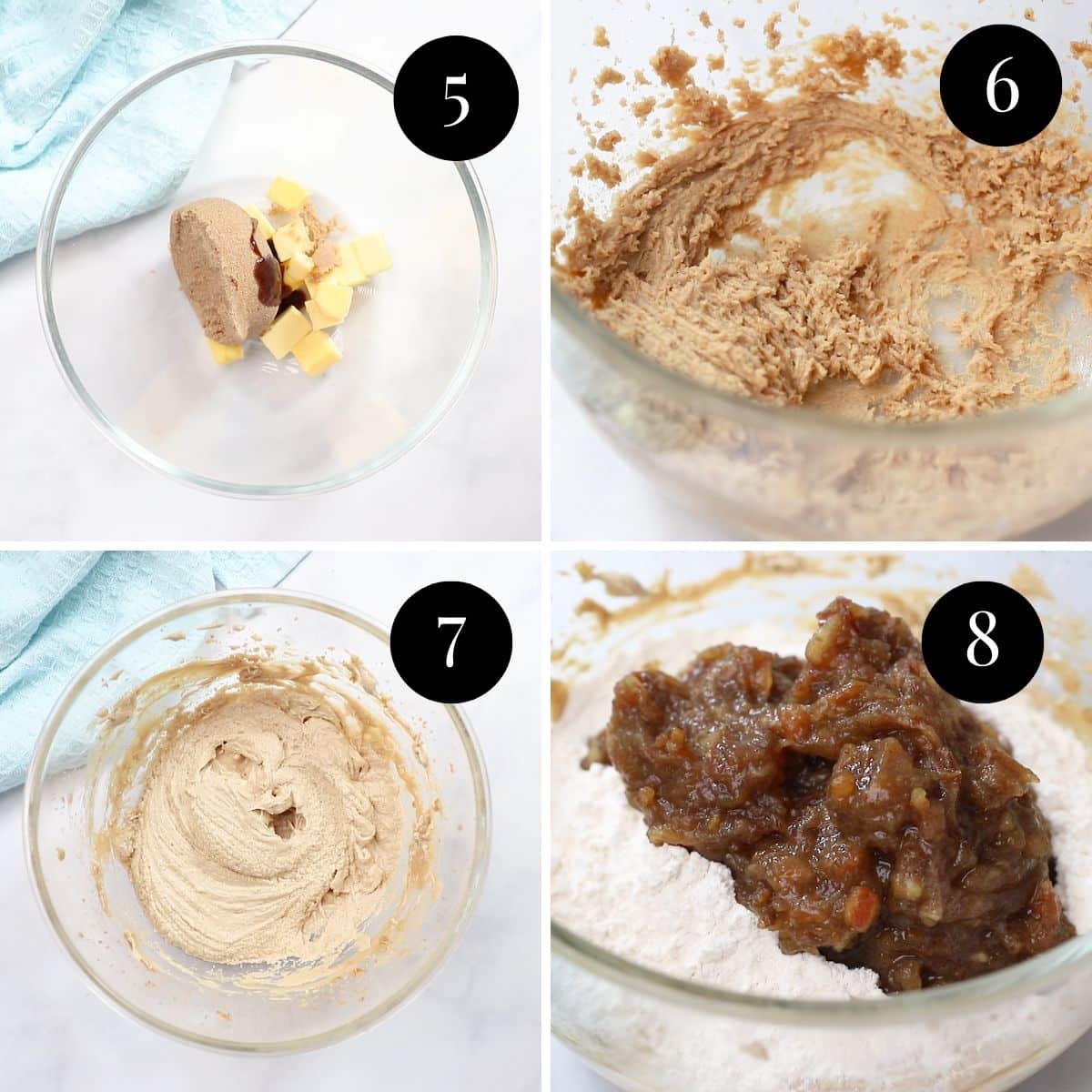
Step 3 – Bake;
*When pre-heating the oven, add a baking tray filled with water to the bottom shelf. This creates a steamy environment for the puddings to bake, making them extra moist!
For individual puddings in a muffin tin;
Grease the muffin trays with butter and dust some brown sugar in the bottom of the holes. Tap out the excess sugar.
Divide the batter between the muffin trays, being careful not to fill them more than ⅔ full. (A ⅓ cup capacity muffin tray should make around 10 puddings). Larger capacity muffin trays can be used, but cooking times may vary.
Bake until the puddings are fluffy and a skewer inserted into the centre comes out mostly clean.

Step 4 – Make the caramel sauce;
While the puddings are baking, start on the caramel sauce.
- Place the cream, brown sugar and butter into a saucepan and bring to a low simmer.
- Stirring occasionally, simmer until the sauce thickens slightly and becomes a light golden colour (around 3-5 minutes). See photo 12.
Step 5 – Soak the puddings;
While the puddings are still hot, use a wooden skewer or fork to poke holes into the surface of the puddings.
Spoon 1-2 tablespoons of caramel sauce onto each pudding and let them soak for 5-10 minutes.
Turn the puddings onto plates and serve warm with additional caramel sauce and cream or ice cream.
For individual puddings in moulds;
The baking time below is based on using 6 pudding moulds (or timbale moulds) with a ½ cup capacity (with 8cm diameter x 5cm height). Any size can be used, but quantities and baking times may vary.
To grease the pudding moulds, add butter around the bottom and sides and dust them with brown sugar. Tap the excess brown sugar from the moulds.
Add the pudding batter (no more than ⅔ full) and bake until spongy on top and a wooden skewer inserted into the middle comes out clean.
Before removing the puddings from the moulds, use a skewer or fork to poke holes into the surface of the puddings. Add 1-2 tablespoons of caramel sauce to the top of each pudding and soak for 5-10 minutes.


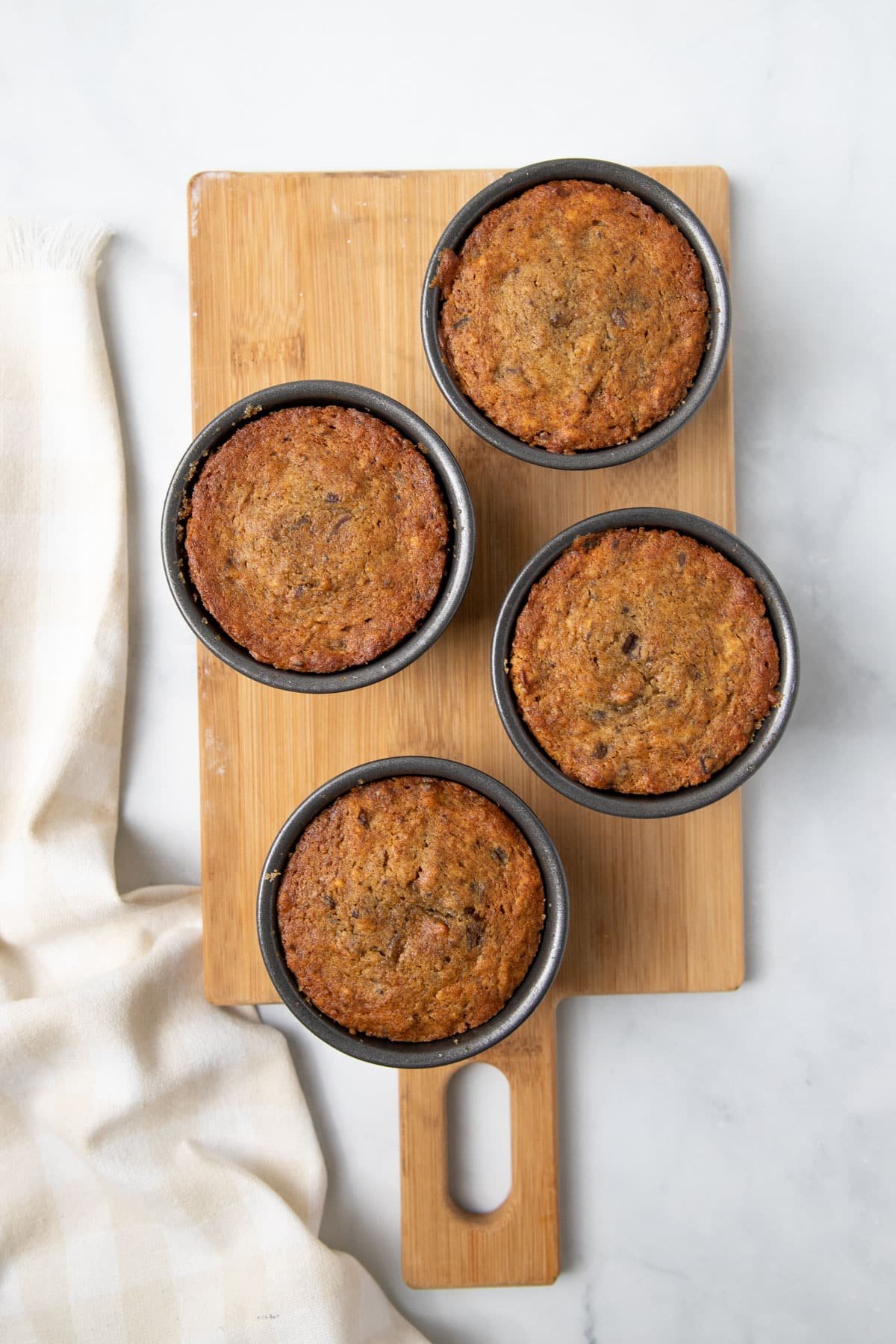

For one whole pudding;
Baking times in the recipe card below are based on a square 20cm x 20cm (8 x 8 inch) cake tin. Any cake tin can be used, but baking times may vary.
Grease the tin with butter and line with baking paper. Leave the paper slightly overhanging at the sides, to make it easier to remove the pudding later.

While the cake is still hot, poke holes into the top and pour about ½ cup caramel sauce over the top, allowing it to soak into the cake for 5-10 minutes. Serve slices with the remaining caramel sauce and cream or ice cream.
Expert tips
- This recipe is for individual puddings. But it can be baked as one pudding in a cake tin, greased and lined with baking paper. While I’ve included instructions for both below, the cooking times may need to be adjusted depending on the size of the baking tin used.
- Finely chop the dates so that they incorporate nicely into the pudding. Once softened, they can be mashed or blended in a food processor before folding them through the batter.
- Add a roasting tray filled with water to the bottom shelf of the oven while it pre-heats. This makes a nice, steamy environment for the puddings, keeping them ultra-moist. Leave the water in the oven while the puddings bake.
- Once removed from the oven, poke holes into the top of each pudding. Add a little caramel sauce to each pudding and let it soak in the tin for 5 minutes before you remove them. Doing this while the cakes are hot allows the caramel sauce to soak into the cakes, making them super moist. Be sure to keep extra sauce for serving, of course!
- Both the puddings and the sauce can be made in advance, to be reheated before serving. They will keep for 3-4 days, tightly covered in the fridge.
- The sauce will thicken if refrigerated, but will thin out when heated in the microwave or in a saucepan.
- Individual pudding moulds; my pudding moulds are 8cm diameter x 5cm height, ½ cup volume. This size makes 6 individual puddings. Any size pudding mould will work (cooking times may vary), but don’t fill them more than ⅔ full or they may overflow. They also need room at the top to add a little sauce at the end.
- Muffin tray puddings; this recipe will make 8-10 small puddings when baked in a muffin tray, depending on the size of your cupcake/muffin tins. I made them in a tray with ⅓ cup volume and got 10 puddings. Larger trays can be used (baking times will vary).
- Whole pudding; you can make the batter into one whole pudding, to slice and serve. I used a 20 x 20cm (8 x 8 inch) square cake tin, which makes 9-12 serves, depending on how big you want them.
FAQs
Leftover sticky date pudding will keep in the fridge for 3-4 days. Poke holes in the hot puddings and soak them with sauce, reserving the remaining sauce for serving. To store, allow the puddings to cool, cover well and refrigerate. Store the remaining sauce separately, in a glass jar. Leftovers can be reheated in the microwave. The sauce will thicken in the fridge, but will thin out when heated in the microwave.
Sticky date pudding is perfect for making ahead, because it is so moist and reheats beautifully. The best way to reheat the puddings is in the microwave, because it keeps the cake moist. Reheat individual serves in bowls for 20-30 seconds, or until steamy and heated through. The reserved caramel sauce can be reheated on the stovetop, or in a jug in the microwave. Serve with the remaining sauce.
Freeze sticky date pudding in individual serves, or whole, for up to 2 months. To freeze, wrap the cooled serves in plastic wrap and add to airtight containers. The extra sauce can be added to the pudding, or frozen separately in plastic bags to serve later. Thaw at room temperature before reheating.
Sticky date pudding is best served warm from the oven, after the caramel sauce and soaked into the cake and while the cakes are ultra-soft. To serve, invert the puddings onto plates and cover with more caramel sauce. Add a dollop of whipped cream, a drizzle of thickened cream or a scoop of vanilla (or salted caramel) ice cream.
Either can be used, but I recommend fresh Medjool dates for their rich caramel flavour and dark colour. Medjool dates add sweetness, moisture and richness to the pudding.

Related recipes
Tried this recipe? Please leave a star ⭐⭐⭐⭐⭐ rating or leave a review below and let me know how you went!
Hungry for more? Subscribe to my newsletter and follow along on Facebook, Instagram and Pinterest for the latest recipes and news.
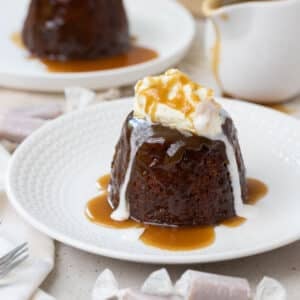
Sticky Date Pudding (Individual or Whole)
Ingredients
- 180 grams Medjool dates pits removed and very finely chopped (weight 180 grams after pits removed)
- ¾ cup boiling water
- ½ teaspoon baking soda bicarb soda
- 60 grams unsalted butter softened at room temperature
- 100 grams light brown sugar ½ cup
- 1 teaspoon vanilla paste or vanilla extract
- 1 large egg at room temperature
- 1 pinch table salt
- 140 grams self raising flour about ¾ cup
For the caramel sauce
- 1 cup thickened cream
- 1 cup light brown sugar
- 60 grams butter
To serve (choose your favourite!)
- whipped cream or double cream unsweetened
- vanilla ice cream or salted caramel ice cream
- custard
Instructions
- Place a baking tray filled with water onto the bottom shelf of the oven so that as the oven heats, it will become nice and steamy for the puddings.
- Pre-heat the oven to 180°C/356 F (160°C fan forced).
- Place the Medjool dates onto a board and chop them into very fine pieces.
- Add the dates to a saucepan over low heat, along with the boiling water and bicarb/baking soda. Stir and bring to a low simmer.
- Simmer until foamy (1-2 minutes) and turn off the heat. Allow the dates to sit for at least 10 minutes, to soften and cool.
- Place the butter, brown sugar and vanilla into a mixing bowl. Using hand-held beaters or a wooden spoon, beat until pale and smooth.
- Add the egg and continue to beat, until incorporated and fluffy.
- Mash the dates with a fork or place them into a food processor and blend until smooth.
- Add the self-raising flour, salt and mashed dates to the butter mixture and fold until just combined.
For individual puddings in moulds
- Grease 6 x ½ cup pudding/timbale moulds (8cm at top, 5cm height) with butter and shake a little brown sugar into the bottom of the moulds. Tap the excess sugar from the moulds.
- Spoon the batter into the pudding moulds, filling no more than ⅔ full.
- Bake on an oven shelf above the tray of water, for 17-20 minutes, or until a skewer inserted into the middle comes out mostly clean.
- While the puddings are baking, start on the caramel sauce.
- Leaving the puddings in the moulds, poke holes in the surface with a skewer.
- While the puddings are still hot, spoon 1-2 tablespoons of the caramel sauce over the tops of the puddings and leave to soak for 5-10 minutes.
- Turn the puddings onto plates (if needed, run a blunt knife along the edges to loosen) and serve warm, with the remaining caramel sauce and cream or ice cream.
For one whole pudding
- Grease a 20 x 20 cm square cake tin with butter and line with baking paper.
- Add the batter to the cake tin and bake for 30 minutes, or until a skewer inserted into the middle comes out mostly clean.
- While the pudding is baking, start on the caramel sauce.
- While the cake is still hot (and in the tin), poke holes into the top of the cake and pour about ½ cup of the caramel sauce over the top. Leave to soak for 5-10 minutes.
- Lift the cake from the tin and cut into slices of desired size (8-12 serves). Serve warm, with the remaining caramel sauce and cream or ice cream.
For muffin tin
- This cooking time is for a muffin tray with ⅓ cup capacity, but larger trays can be used (cooking times will vary).
- Grease the muffin tray holes with butter and dust with brown sugar to stick to the butter. Tap the excess sugar from the trays.
- Spoon the batter into the muffin holes, filling them no more than ⅔ full.
- Bake for 12-15 minutes, or until a skewer inserted into the centre comes out mostly clean.
- While the puddings are baking, start on the caramel sauce.
- Leaving the puddings in the tray, poke holes in the surface with a skewer.
- While the puddings are still hot, spoon 1-2 tablespoons of the caramel sauce over the tops and leave them to soak for 5-10 minutes.
- Turn the puddings onto plates (if needed, run a blunt knife along the edges to loosen) and serve warm, with the remaining caramel sauce and cream or ice cream.
For the caramel sauce
- Place the sauce ingredients in a saucepan over medium heat and stir until the butter has melted. Bring to a simmer.
- Reduce the heat to low and simmer for 3-5 minutes, until the sauce is smooth, glossy and a light golden colour.
- Remove from the heat and serve warm.
Video
Notes
- This recipe is for individual puddings. But it can be baked as one pudding in a cake tin, greased and lined with baking paper. While I’ve included instructions for both below, the cooking times may need to be adjusted depending on the size of the baking tin used.
- Finely chop the dates so that they incorporate nicely into the pudding. Once softened, they can be mashed or blended in a food processor before folding them through the batter.
- Add a roasting tray filled with water to the bottom shelf of the oven while it pre-heats. This makes a nice, steamy environment for the puddings, keeping them ultra-moist. Leave the water in the oven while the puddings bake.
- Once removed from the oven, poke holes into the top of each pudding. Add a little caramel sauce to each pudding and let it soak in the tin for 5 minutes before you remove them. Doing this while the cakes are hot allows the caramel sauce to soak into the cakes, making them super moist. Be sure to keep extra sauce for serving, of course!
- Both the puddings and the sauce can be made in advance, to be reheated before serving. They will keep for 3-4 days, tightly covered in the fridge.
- The sauce will thicken if refrigerated, but will thin out when heated in the microwave or in a saucepan.
- Individual pudding moulds; my pudding moulds are 8cm diameter x 5cm height, ½ cup volume. This size makes 6 individual puddings. Any size pudding mould will work, but don’t fill them more than ⅔ full or they may overflow. They also need room at the top to add a little sauce at the end.
- Muffin tray puddings; this recipe will make 8-10 small puddings, depending on the size of your cupcake/muffin tins. I made them in a tray with ⅓ cup volume and got 10 puddings.
- Whole pudding; you can make the batter into one whole pudding, to slice and serve. I used a 20 x 20cm (8 x 8 inch) square cake tin, which makes 9-12 serves, depending on how big you want them.
- Storage; Leftover sticky date pudding will keep in the fridge for 3-4 days. Poke holes in the hot puddings and soak them with sauce, reserving the remaining sauce for serving. To store, allow the puddings to cool, cover well and refrigerate. Store the sauce separately in a glass jar. Leftovers can be reheated in the microwave.
- Reheating; The best way to reheat the puddings is in the microwave, because it keeps the cake moist. Reheat individual serves in bowls for 20-30 seconds, or until steamy and heated through. The reserved caramel sauce can be reheated on the stovetop, or in a jug in the microwave. Serve with the remaining sauce.
- Freezing; Freeze in individual serves, or whole for up to 2 months. To freeze, wrap the serves in plastic wrap in airtight containers. The sauce can be added to the pudding, or frozen separately in plastic bags. Thaw at room temperature before reheating.
- Please note that the nutrition information is based on the mixture being made into 8 puddings topped with sauce, with one pudding being one serve. Values will vary depending on whether the pudding is made in muffin trays, moulds or as a whole, sliced pudding. The nutritional information is an estimate only and does not take into account any additional toppings or sides served with the puddings.
- This recipe is made using Australian cups and spoon measurements. Any reference to cups or spoons in this recipe is in Australian metric. Due to cup sizes varying from country to country, I advise adjusting if necessary.




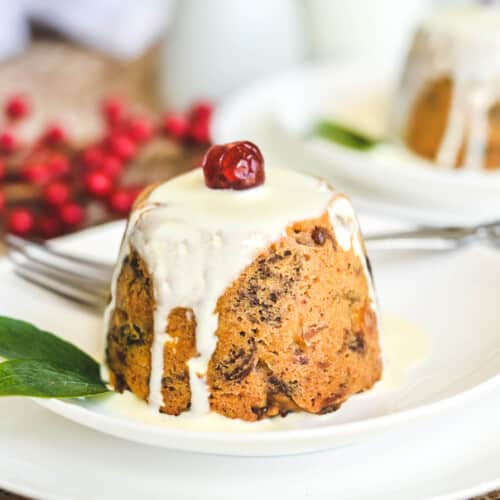
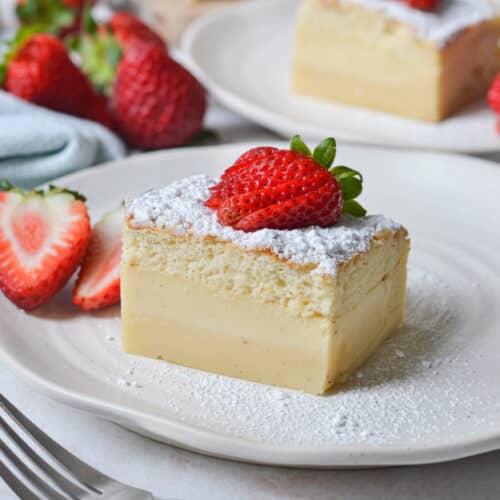
Leave a Reply